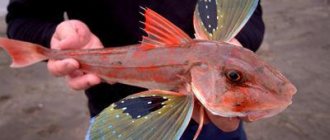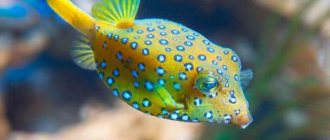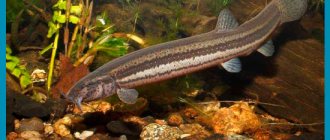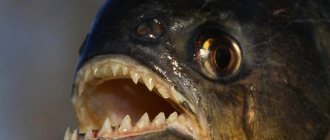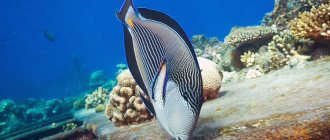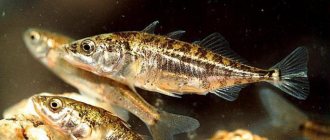| Class | Ray-finned fish |
| Squad | Catfish |
| Family | Pangasiaceae |
| Genus | Pangasiaceae |
| View | Pangasianodon hypophthalmus |
| Security status | Endangered (EN) |
| The average size | Reaches a length of 130 cm and a weight of up to 40 kg |
| Lifespan | Lives up to 20 years in the wild |
| What does it eat? | Omnivores - small fish, shellfish, algae, vegetables, fruits, rice, etc. |
| Optimal feeding time | Morning and evening hours |
Pangasius is a freshwater fish whose habitat is in Southeast Asia. Thanks to its low cost and availability, it has gained popularity among the population. But ordinary consumers are interested in the question: how suitable is this species for food?
The article talks about the significant factors influencing the quality of the product - where it lives, how it is grown on fish farms, processing methods. The question of whether its use is harmful or beneficial to the body is covered in detail. Recommendations are given on how to prepare delicious dishes from this fish.
Pangasius - what kind of fish
Pangasius is a freshwater fish of the catfish family. In common parlance - shark catfish . This is due to the sharp shape of the fin, similar to a shark's. The fish lives mainly at the bottom of rivers, has a timid character, and is quite active.
Pangasius is omnivorous. It can feed on both living creatures (small fish, crustaceans, plankton, mollusks) and algae. On farms where pangasius is grown, it is fed with a special granulated feed consisting of fish waste, enriched with minerals and useful bioadditives.
Beneficial features
Shark catfish meat contains many substances necessary for the human body:
- Magnesium;
- Calcium;
- Phosphorus;
- Potassium;
- Iron;
- Fluorine;
- Zinc;
- Vitamins.
Calcium strengthens the skeletal system. Micro and macroelements heal the cardiovascular system, prevent the occurrence of heart disease, normalize brain function, improve vision and memory, and normalize blood pressure. Vitamins have a beneficial effect on the beauty of skin and hair.
Shark catfish have higher levels of omega-3 fatty acids and proteins compared to other river fish. Fatty acids increase the flexibility of blood vessels, thereby preventing the formation of atherosclerosis and osteoporosis.
According to experts, amino acids and omega-3 contained in fish improve sleep, help fight stressful situations, constant fatigue, and normalize metabolism. Fish meat proteins are absorbed and processed by the body much better than proteins of animal origin.
The low calorie content of the product (89 kcal per 100 g) allows it to become indispensable for dietary nutrition, for weight loss and for restoring the body after illnesses. Pangasius meat is favorable for feeding patients with diabetes, as its glycemic index is very low.
Pangasius - habitat
The habitat of fish in natural conditions is freshwater lakes and rivers of Indochina , namely Vietnam, Laos, Cambodia, Thailand. The two leading rivers in terms of shark catfish population are the Mekong and Chao Phray. These rivers are extremely polluted with household waste, chemical plant effluents, and toxic substances sprayed during the Vietnam War.
Pangasius feels great in an aquarium , so fish lovers really liked it. Due to its cowardly nature, at first the fish rushes from side to side in the aquarium, demolishing everything in its path. She may pretend to be dead or faint. But soon her behavior returns to normal.
We also recommend reading:
Bleak fish: description of where buckle, sintya, and whitefish live List of fish: whitefish species muksun, omul and vendace Smelt fish: benefits and harms, habitat, preparation Who is whitefish?
Cooking secrets
If you follow the universal cooking rules, the fish will turn out tender and aromatic:
- To maintain a dense structure and taste, defrost the carcasses at room temperature for 3-4 hours or on the bottom shelf of the refrigerator for 10-12 hours. It is not recommended to pour water over the fillets or use the microwave to speed up thawing.
- Remove excess moisture from the defrosted pulp using paper towels or napkins, then the fish will not disintegrate during cooking.
- Cooking time takes 8-10 minutes. Do not keep pangasius in water longer than expected, so that the meat does not boil and disintegrate into fibers.
- For optimal salting when baking or frying, 1 level teaspoon of salt per 1 kg of fillet is enough.
In cooking, fish is used in different ways - stuffed into pies, stewed with vegetables, baked with fruit, boiled and smoked. We offer you to prepare simple and tasty pangasius dishes according to our recipes.
Pangasius meatballs in tomato
Ingredients:
- fish fillet – 1 kg;
- tomato paste – 1 tbsp;
- onions – 4 pcs.;
- garlic – 2 cloves;
- city bun – 1 pc.;
- milk – 200 ml;
- tomatoes – 0.5 kg;
- carrots – 2 pcs.;
- flour – 3 tbsp;
- sugar – 2 4.l.;
- salt;
- black pepper;
- spices for fish;
- greenery.
Preparation:
- Cut the bun and soak it in milk. To make the meatballs more tender, you can use only the crumb.
- We pass two onions, along with fish and bread, through a meat grinder.
- Squeeze a clove of garlic into the resulting minced meat, add salt, sprinkle with black pepper and mix.
- Cover with cling film and put in the refrigerator for 20 minutes.
- Grate the carrots, cut the onion into half rings and fry them in a deep saucepan in vegetable oil for 10 minutes.
- Pour boiling water over the tomatoes, peel them, then cut them into large cubes and add them to the vegetables.
- Cover with a lid and simmer for 10 minutes.
- At this time, we form meatballs from minced meat, roll them in flour and fry on both sides until golden brown.
- In a separate frying pan, sauté the flour until slightly golden brown, stirring all the time. Do not overcook, otherwise the sauce will be bitter.
- Pour the flour into a saucepan, stir well, add tomato paste.
- Pour fish spices, sugar, salt into the sauce, mix and simmer for 3 minutes.
- Place the meatballs in a saucepan. Make sure the sauce covers them completely. If necessary, add water.
- Cover with a lid and simmer for 15 minutes. Before serving, sprinkle with herbs.
Pangasius in sauce with vegetables
Products:
- asparagus – 200 g;
- bell pepper – 4 pcs.;
- fresh green peas – 100 g;
- shark catfish pulp – 700 g;
- carrots – 2 pcs.;
- salt, pepper - to taste.
For the sauce:
- sour cream 20% – 150 g;
- hard cheese – 100 g;
- mustard – 50 g;
- lemon juice – 50 ml.
Preparation:
- Cut the vegetables into medium cubes and mix, add peas.
- We cut the fillet into portions, pepper and add salt to each piece.
- Line a heat-resistant dish with foil, lay out the vegetables and fish on top.
- Grate the cheese on a fine grater.
- Mix all the ingredients for the sauce, pour over the vegetables and fish and cover tightly with foil.
- Place the pan in an oven preheated to 180 degrees for 25 minutes.
- Open the foil and bake for another 5 minutes.
- Before serving, decorate with parsley sprigs.
Gallery: pangasius fish (25 photos)
Lifespan of shark catfish
As a rule, the average lifespan of a pangasius is about twenty years.
Its maximum length can be 130 centimeters, and the weight of the fish is 44 kilograms. This is a bentho-pelagic species, living at temperatures of 22-260. Females reach sexual maturity closer to three years of age, and males a year earlier. A ten-kilogram adult fish is capable of throwing more than 1,000,000 eggs . Reproduction of wild individuals occurs twice a year, however, in some reservoirs of Vietnam, spawning is recorded with an interval of 6 to 17 weeks. The life cycle of pangasius is tied to changes in water levels in the river and the monsoon climate. During the dry season, this species and many others swim into deep pools. Spawning areas include sandbanks, rapids, and sandbanks with rocky areas. The eggs are laid directly on the roots of rheophilic plants, since they are covered with a sticky membrane. This fish was artificially introduced into the waters of Asian countries:
- India;
- China;
- Bangladesh;
- Malaysia;
- Indonesia;
- Myanmar.
Pangasius - harm and benefit
Pangasius does not have a good reputation among most buyers. There is an opinion that this fish is harmful to health and can be poisoned. This is not surprising, because it lives in the Mekong River polluted by chemical waste. It is not clear how it survives in such conditions, because pangassis loves clean water. Even when keeping this fish in an aquarium, the water is constantly filtered.
But we should not forget that fish for sale are grown in special fish farms, where the condition of the water must be strictly controlled, as well as feeding. This applies to self-respecting farms. Many of these enterprises are located on the Mekong River, the fish is grown there and frozen in the same water. When analyzing the composition of shark catfish, a high content of harmful phosphates and the presence of E. coli were revealed. Despite the fact that the fish gains weight quite quickly on its own, its growth is stimulated with special additives, which also will not benefit humans. Therefore, when purchasing, you should inquire where the fish was brought from.
What products does it combine with?
Pangasius pulp should be cooked only with products with which it is combined.
Following this rule will ensure good digestibility and prevent heartburn and heaviness in the stomach. Compatibility table with other products
| Fine | Ghee, whey, greens, cabbage, carrots, beets, pickles, green vegetables |
| Acceptable | Rice, buckwheat, lemon, quinoa, tomatoes, butter, vegetable oil, pumpkin, eggplant, zucchini |
| Badly | Meat, poultry, eggs, mushrooms, cream, sour cream, lard, nuts, seeds, potatoes, dairy products, cheeses, feta cheese, wheat, rye, oats, bread, peas, chickpeas, mung beans, beans, beans, lentils, |
How to choose pangasius
If you still decide to buy this product, when choosing, pay attention to its color. If it is red or yellow, this fish is not suitable for food. The red color is due to chemical processing of the product, and the yellow color is due to a lack of nutrients in feeding and a harmful development environment. The color of pangasius should be soft pink, closer to white.
Not only the fish itself can cause harm to the body, but also its improper storage. You should familiarize yourself with the method of freezing shark catfish: it should be written on the packaging that the pangasius was frozen using the shock method. It is better to buy fish in specialized stores or supermarkets, where all products have the appropriate documents and certificates. When buying pangasius on the market, you risk purchasing a low-quality or improperly stored product.
The packaging must be vacuum sealed and indicate the name of the manufacturer on it. You should know that it’s easy to fill fish fillets with water. Unscrupulous manufacturers can increase the percentage of water content in the product to 30%. Therefore, give preference to whole carcasses or steak. The production technology is such that it is impossible to fill a whole carcass and steak with a large amount of liquid.
In addition to vacuum packaging, on the shelves you can find pangasius covered with a thin layer of ice. There is nothing wrong with this; on the contrary, in this form the fish will fully retain its beneficial properties. But you should make sure that the ice layer is not very thick. The seller may specifically use more ice to increase weight.
So, information about pangasius fish is quite contradictory. Whether you are an opponent or a defender of the use of this product in food is up to you personally.
Farming Basics
The main exporter of Pangasius to Europe and the USA is the countries of Southeast Asia, in particular Vietnam. For these purposes, fish are bred both in small farms and in large enterprises that have the appropriate licenses.
The water in reservoirs is regularly filtered and aerated using powerful devices. For feeding, farmers use special granules enriched with vitamins and minerals.
Pangasius is grown up to six months of age. After partial drainage of the reservoir, adult individuals weighing 800 g or more are caught using nets.

